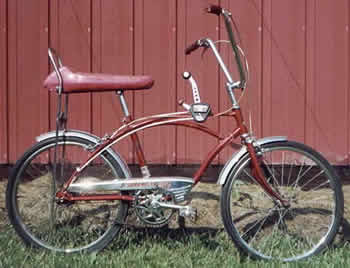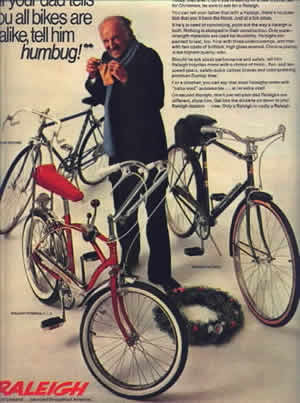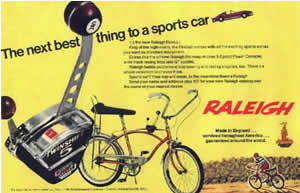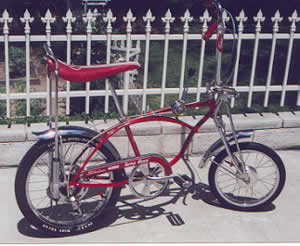|
Starting
to get Interesting.....
Over here
in the home country of Raleigh, little is known of our favourite
bike manufacturer's activities in America. Well, I'm here to spill
the ugly tin of beans...... Raleigh had for some time been, basically,
copying every move that Schwinn made.
Raleigh always had a range of bikes exclusively for the US market
that never appeared on our shores. These bikes usually had the Schwinn
style cantilever frame design, with two thin crossbars curving gracefully
up from the rear wheel to the headstock. Also, unlike our familiar
front forks with chrome 'dimples', seen on UK Raleighs, the US bikes
often had a front fork almost identical to Schwinn's.
It comes as no surprise, then, to discover that Raleigh, seeing
the popularity of the Schwinn Stingray, and in unison with every
other company selling bikes in America, soon brought out a Stingray
lookalike.

The
Raleigh Rodeo had 20 inch wheels, apehangers,and basically was a
Stingray clone. Unlike the Stingray, it had thin wheels, taken straight
off the standard Raleigh 20in boys' bike. .Also, it had Sturmey
Archer 3 speed rear hub changed by a stickshift on the cantilever
frame...... There was one big difference between the Rodeo and the
Stingray and its other clones.........Yes, we're back in seat territory
again folks.......
In
common with the Stingray, all the other manufacturers of apehanger
bikes used the Pearsons style solo polo seat, in various designs,
often metalflake! (often called 'banana' seats) However, our hero,
the Raleigh Rodeo, set itself apart from these upstarts, and proved
its family ties to the Raleigh Chopper, by having a thick padded,
pleated vinyl seat, which next appeared on the Raleigh Chopper range,
but hey, we've a little tale to tell before we finally reach our
goal. The Rodeo lasted well, it was released in 1966 and was still
on sale in 1970. It had several colour variations, and was available
in 3 speed or 3+2 5 speed. It even made a brief appearance in the
UK Raleigh sales catalogue....anyone got one?
Raleigh
tried to keep up with Schwinn, and realised that although the Rodeo
was selling, it was lacking a little something. In late 1967, the
1968 Raleigh Fireball was released into US dealers, the Fireball
was a little tougher variation of the Rodeo.


The
Fireball finally had a larger width rear wheel....shod with a cool
Raleigh gold dot rear slick tyre. It retained the family thick padded
seat, available in red vinyl on the red Fireball. The Fireball still
retained the Schwinn cantilever style frame however, and was available
with Dunlop whitewall tyres.
By
1968 Schwinn had stamped its authority on the youth bicycle market
in America. The Stingray was selling well, and it was time for a
new Stingray to catapult Schwinn sales into the 1970s. What Schwinn
did was take the chrome springer front forks off its 24 inch wheeled
bike, fit it to a 20 inch Stingray frame, and lower the front end
back down by fitting a 16 inch front wheel. This was the unfortunately
named 'Krate' bike, for some unimaginable reason. Schwinn designers
named their hard hitting, youth oriented new bike after a fruit
box........ Orange Krate and Apple Krate being the first two models,
being orange and green respectively.

1972 Apple
Krate
Our
little pal , the Raleigh Fireball had been selling in respectable
numbers, but the introduction of the Schwinn Krate series, running
alongside the expanded Stingray range, basically nailed the coffin
shut on the competition.
In
an unusual move, Raleigh decided, for the first time in their life,
to design a new bike for the American market that wasn't a direct
copy of a Schwinn. The Fireball had run its course, and Raleigh's
chief designer, Alan Oakley, was put on a 'plane for the west coast
of America to have a look at what was going on, and cast a fresh,
unprejudiced eye over the youth bike scene. Legend has it that Alan
sketched the Raleigh Chopper on the back of an envelope on his return
flight. This may or may not be true, but if the Fireball was the
daddy of the Chopper, Allan Oakley was its midwife.
 ............................................. .............................................
|





